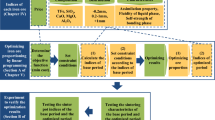Abstract
In this paper, a multi-objective decision model is formulated utilizing both single-layer and three-layer radon reduction layer materials by considering radon emanation rate and cost as decision objectives. Through a multi-objective non-dominated ranking method, the optimal solution is identified from a range of feasible alternatives. In the case of the example uranium tailings pond, the optimized three-layer radon reduction layer materials reduce the comprehensive cost by 47.8% compared with the single-layer radon reduction layer materials while meeting the radon emanation rate limit. Furthermore, the utilization of non-dominated multi-objective optimization techniques demonstrates higher efficiency in optimizing each radon reduction layer schemes.






Similar content being viewed by others
References
Wagner F, Jung H, Himmelsbach T et al (2015) Impact of uranium mill tailings on water resources in Mailuu Suu. Springer International Publishing, Kyrgyzstan
Wang ZZ (2003) Environmental management of uranium tailings pond decommissioning. Uranium Min Metall 22(2):95–99
Yan X (2015) Migration and distribution of radionuclide in uranium tailing soil and the effects of radionuclide on soil microbial diversity. Northeast Forestry University (Doctoral thesis)
Yan X, Luo XG (2015) Radionuclides distribution, properties, and microbial diversity of soils in uranium mill tailings from southeastern China. J Environ Radioact 139:85–90
Wang HT (2008) Dynamics of fluid flow and contaminant transport in porous media. Higher Education Pres. Beijing
Panigrahi DC, Mishra DP, Sahu P (2015) Evaluation of inhalation exposure contributed by backfill mill tailings in underground uranium mine. Environ Earth Sci 74(5):4327–4334
Dai JY, Wang M, Zou SL (2016) Hybrid intelligent optimal selection research of cover materials in uranium tailing pile. Atomic Energy Sci Technol 50(07):1329–1335
Ban GG, Dai JY (2019) Simulation study of clay layer coverage governance of uranium tailings pile. Ind Safety Environ Protect 45(01):83–86
Zhang H, Xu LC, Li XJ (2017) Comparison on radon suppression effects of covering tests between waste rock heap and tailing ponds. Radiat Protect 5:387–392
IAEA (1994) Decommissioning of facilities for mining and milling of radioactive ore and closeout of residues. Technical reports series No. 362. Vienna: IAEA
The National Standards Compilation Group of Peoples Republic of China (2020) GB/T 23727–2020 Regulations for radiation protection and radiation environment protection in uranium mining and milling. China Planning Press, Beijing
Zhou CC, Yin FG, Hu XB et al (2008) Multi-objective optimization decision-making of material selection oriented to green design. Comput Integrat Manuf Syst 2008(05):1023–1035
Li XT (2001) Optimization Analysis for cover thickness of uranium tailings impoundment (2001). Uranium Min Metall 01:28–34
Tan KX, Hu HQ, Liu ZH et al (2012) An exploration on the effectiveness of suppression of radon exhalation from uranium tailings by using different cover materials. Acta Mineral Sin 32(02):233–237
Xie TF, Li JL, Wang L (2013) Parameter optimization of clay for radon attenuation covered on uranium tailings. Radiat Protect 33(04):243–248
Rogers VC, Nielson KK, Merrell GB (1989) Radon generation, adsorption, absorption, and transport in porous media. Rogers and Associates Engineering Corporation
Barnekow U, Paul M (2013) .Fifteen years of design, construction and monitoring of soil covers on Wismut's uranium mining legacy sites—a synopsis. Mine Closure
Gao Y (2006) Non-dominated sorting genetic algorithm and its applications. Zhejiang University (Doctoral thesis)
Tian Y, Cheng R, Zhang XY et al (2017) PlatEMO: A MATLAB platform for evolutionary multi-objective optimization. IEEE Comput Intell Mag 12(4):73–87
Anon (1992) Measurement and calculation of radon releases from uranium mill tailings. Technical reports series No. 333. Vienna:IAEA
Srinivas N, Deb K (1994) Multiobjective optimization using nondominated sorting in genetic algorithms. Evolut Comput 2(3):221–248
Wang LP, Feng ML, Qiu QC et al (2019) Survey on preference-based multi-objective evolutionary algorithms. Chin J Comput 42(6):1289–1315
Wang M (2016) Hybrid intelligent optimal control research of radioactive contaminants in uranium tailings pile. University of South China (Master thesis)
Ban GG (2018). Optimization research of coverage materials for uranium tailings pile under multi field coupling. University of South China (Master thesis)
Ding SZ (2015) Construction project construction management. China Construct Ind Press Beijing 2015:39–127
Zhang H, Lu AL (2018) Research on value, price and interest of sandstone resources. China Mining Magz 2018(1):63–65
Zhou HJ, Feng S (2017) Cement price outlook in 2017. Eng Cost Manag 2017(2):91–94
Acknowledgements
This work is supported by the University-level research project of University of South China (No. 210XQD029).
Author information
Authors and Affiliations
Corresponding author
Ethics declarations
Conflict of interest
The authors of this manuscript have no competing or conflict of interest with any person or any organization.
Additional information
Publisher's Note
Springer Nature remains neutral with regard to jurisdictional claims in published maps and institutional affiliations.
Rights and permissions
Springer Nature or its licensor (e.g. a society or other partner) holds exclusive rights to this article under a publishing agreement with the author(s) or other rightsholder(s); author self-archiving of the accepted manuscript version of this article is solely governed by the terms of such publishing agreement and applicable law.
About this article
Cite this article
Deng, N., Ding, D. Optimizing material selection and the thickness of radon reduction layer in uranium tailings pond. J Radioanal Nucl Chem 333, 205–213 (2024). https://doi.org/10.1007/s10967-023-09244-1
Received:
Accepted:
Published:
Issue Date:
DOI: https://doi.org/10.1007/s10967-023-09244-1




